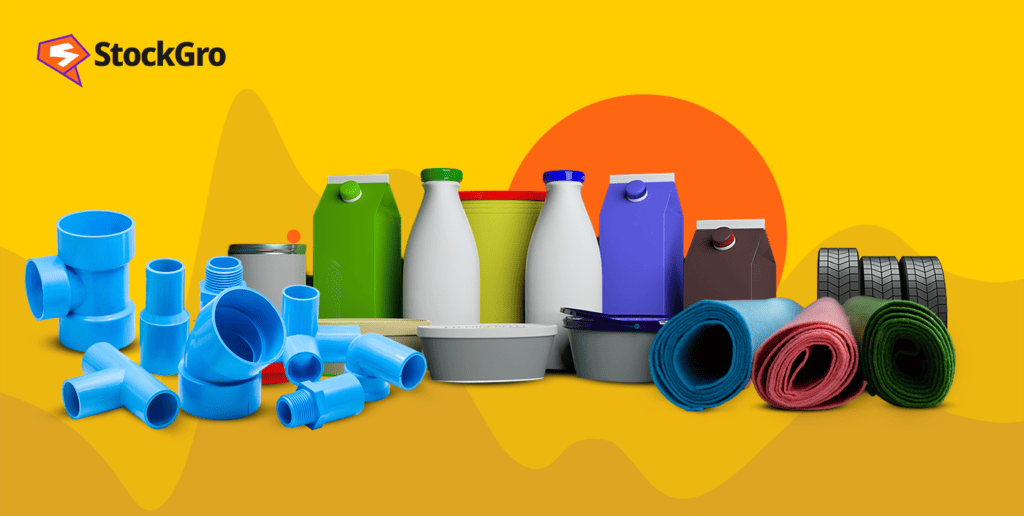
The term “rubber and plastics market” describes the production of a wide variety of rubber and plastic goods using raw materials such as polymer compounds, synthetic and natural rubber, and plastic resins.
The manufacture of polystyrene in 1957 marked the beginning of India’s plastic industry. The sector has advanced significantly and expanded significantly since then. On the other hand, India consistently produces 6% of global rubber annually, even though the global rubber market has been highly volatile in recent years.
The plastics exports in India are predicted to be worth US$4.7 billion in 2024. At the same time, the All India Rubber Industry Association estimates that natural rubber production will increase by 5% in 2023–2024 from 8 lakh metric tonnes in the previous fiscal year.
Keeping these statistics in mind, let’s take a closer look at India’s rubber and plastic industries, the future of these industries and the leading companies in these sectors.
Understanding the rubber industry in India
Globally, India ranks third in terms of production, fourth in terms of consumption, and fifth in terms of combined consumption of natural and synthetic rubber. The Indian rubber industry, which produces 35,000 rubber goods, is a vital component of the country’s economy today.
All varieties of heavy-duty earth-moving tyres are among the many rubber goods produced by the Indian rubber sector. This includes tyres for cars, auto components, pipes, cycle tyres, latex goods, pharmaceuticals, and more, as well as mass-produced moulded and extruded items.
The industry provides services to almost every field one can imagine, including defence, aeronautics, food production, and transportation, in addition to textile engineering industries, pharmaceuticals, hospitals, and sports, to name a few.
India’s rubber industry is split into two areas: the tyre and non-tyre sectors. The tyre sector manufactures various kinds of car tyres, including radial and conventional tyres, and sells them to developed nations.
On the other side, the medium-scale, small-scale, and microscopic units make up the non-tyre sector. This segment creates advanced machinery and high-tech products. Based on the amount of rubber used, the automobile tyre industry is the largest, using almost 50% of all rubber kinds.
More than ninety per cent of India’s natural rubber is produced in Kerala, which has 3.84 lakh hectares of rubber plantations on its own and produces 3.70 lakh tonnes of rubber annually.
Also read: Ethical dilemma of taxing alcohol and cigarettes
Understanding the plastic industry in India
The United States and China are the two biggest consumers of plastics, with India coming in at number three, with an estimated six per cent of the world’s consumption. India might become the primary plastics supplier to the global market.
For the Indian plastics market to emerge as the centre of global sourcing, companies and the government are collaborating to promote development further and provide a sustainable environment.
In four to five years, the Indian government plans to boost the plastics industry’s economic output from US$37.8 billion to US$126 billion.
Significant developments have been made in the plastic machinery market and the petrochemical industry, which has remarkably advanced the plastic processing industry.
India’s plastic consumption surged 23 times between 1990 and 2021, reaching almost 21 million tonnes. However, there is a notable geographical difference in India’s plastic consumption: 47% of plastic is consumed in Western India and 23% in Northern India, whereas it is only 21% in Southern India.
There are now over 50,000 industries in the plastics sector, the majority of which are MSMEs. These businesses employ over 50,000 people and add US$42.89 billion to India’s GDP.
With a 60% plastic recycling rate, the nation outperforms developed nations. Production of plastic is on the rise due to the government’s “Make in India,” “Skill India,” “Swachh Bharat,” and “Digital India” campaigns.
Also read: Textile industry in India – The foundation of fashionable clothing trends
Growth and future of the rubber and plastic industry
The rubber and plastics industry is expected to add a value of $11.01 billion by 2024. From 2024 to 2028, it is expected that the compound annual growth rate will be 7.86%.
Forecasts indicate that the rubber and plastics industry will generate $56.77 billion in revenue by 2024. It is estimated that the CAGR from 2024 to 2028 will be 4.06%.
In 2024, the number of businesses in the rubber and plastics market is expected to reach 16,88,000. We may expect a compound annual growth rate (CAGR 2024–2028) of 2.47%.
By 2024, the rubber and plastics market is expected to employ 1.09 million people. A 5.88% compound annual growth rate (CAGR 2024–2028) is anticipated.
Top stocks in the Indian rubber and plastic industry
Below is a list of the leading companies in the rubber industry according to their market capitalisation along with their net profit and share price return (As of January 4, 2023)
| Company | Market cap (₹ cr.) | Total revenue in FY23 (₹ cr.) | Share price % return (1Y) as of January 4, 2023 |
| Apcotex Industries | 2,607 | 1,087.22 | 7.36 |
| Pix Transmissions | 1,821 | 499.80 | 57.82 |
| Tinna Rubber | 993.0 | 301.57 | 154.83 |
| GRP Ltd | 647.0 | 460.52 | 125.39 |
| Rubfila International | 440.0 | 463.70 | 2.02 |
If you are curious about finding the top stocks in the plastics industry in India, here is a list ranked by their market capitalisation on BSE (As of January 4, 2023)
| Company | Market cap (₹ cr.) | Net profit (₹ cr.) | Share price % return (1Y) as of January 4, 2023 |
| Time Techno | 4,096.07 | 111.22 | 94.3 |
| Apollo Pipes | 3,006.73 | 23.91 | 33.51 |
| DDEV PLASTIK | 2,101.68 | 104.10 | 154.31 |
| Prakash Pipes Ltd. | 942.02 | 71.29 | 140.64 |
| Nahar Poly Film | 558.15 | 31.94 | -12.93 |
Also read: Exploring Cement industry in India: A comprehensive overview
Conclusion
The growth outlook and rising demand make India’s rubber and plastics industry an attractive bet for investors. Stocks like Apollo Pipes, Pix Transmissions, and Tinna Rubber offer exposure to this high-potential space. With the government policies in place, the country hopes the rubber and plastic industry to develop even further.

